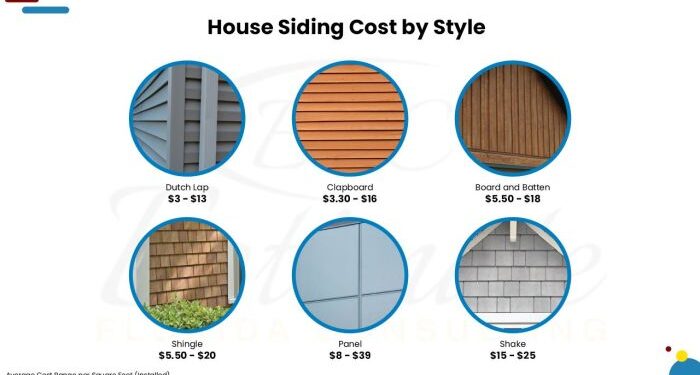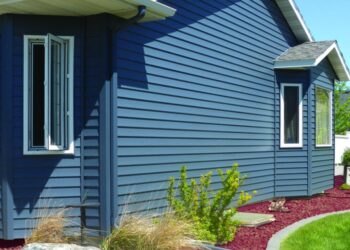Labor cost for siding a house delves into the intricacies of budgeting for this essential home improvement project. From the factors influencing costs to the types of materials used, this guide offers a comprehensive look at what goes into determining labor expenses for siding projects.
As we explore the nuances of labor costs and the impact of siding materials, readers will gain valuable insights into making informed decisions when undertaking a siding project for their home.
Factors influencing labor costs for siding a house
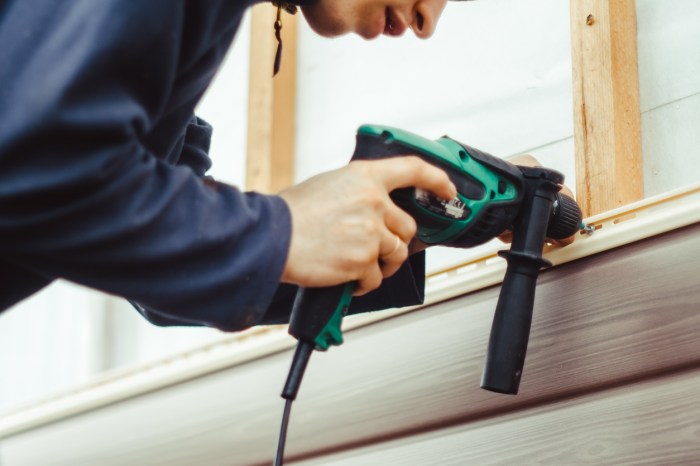
When it comes to determining labor costs for siding a house, several factors come into play that can significantly impact the overall expenses. These factors include the size of the house, the location where the project is taking place, and the complexity of the siding design.
Size of the House
The size of the house is a crucial factor that influences labor costs for siding. Larger houses require more materials and, consequently, more time and effort to complete the siding project. This means that labor costs will be higher for larger houses compared to smaller ones.
Additionally, the layout of the house, such as the number of stories and corners, can also affect the complexity of the project and, consequently, the labor costs involved.
Location
The location of the house plays a significant role in determining labor costs for siding projects. Labor costs can vary depending on the cost of living in the area, as well as local regulations and building codes that may affect the project.
For instance, labor costs in urban areas with high living expenses are generally higher compared to rural areas. Accessibility to the property and transportation of materials can also impact labor costs.
Complexity of the Siding Design
The complexity of the siding design is another factor that can influence labor costs. Intricate designs, patterns, or customizations require more time and expertise to install, leading to higher labor costs. Additionally, the type of siding material being used, such as vinyl, wood, or fiber cement, can also impact labor costs based on the skill level and experience required for installation.
Types of siding materials and their impact on labor costs
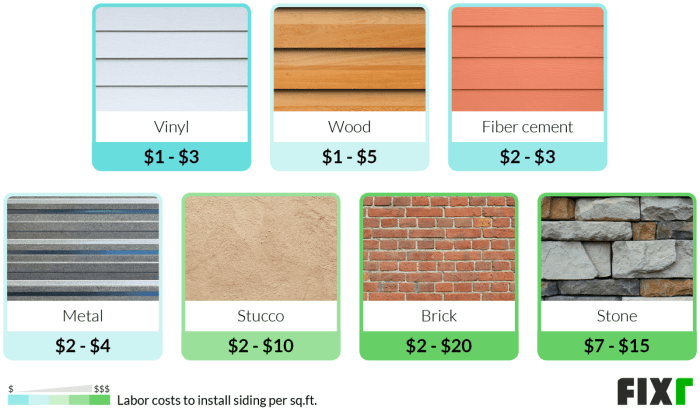
When it comes to siding a house, the choice of materials can significantly impact labor costs. Different siding materials require varying levels of expertise, time, and effort to install, ultimately affecting the overall cost of the project.
Vinyl Siding
Vinyl siding is one of the most popular choices for homeowners due to its affordability and low maintenance requirements. The installation process for vinyl siding is relatively straightforward, making it a cost-effective option in terms of labor. However, intricate designs or patterns may require more time and skill, leading to increased labor costs.
Fiber Cement Siding
Fiber cement siding is known for its durability and resistance to pests and harsh weather conditions. While it is more expensive than vinyl siding, the installation process for fiber cement siding can be labor-intensive. The heavy weight of the material and the need for special tools can increase labor costs compared to other siding materials.
Wood Siding
Wood siding offers a natural and timeless look to a house but requires regular maintenance to prevent rot and decay. The installation of wood siding can be labor-intensive and time-consuming, especially if the wood needs to be treated or painted before installation.
This can lead to higher labor costs compared to other siding materials.
Aluminum Siding
Aluminum siding is lightweight and durable, making it a popular choice for homeowners looking for a low-maintenance option. The installation process for aluminum siding is relatively straightforward, resulting in lower labor costs compared to other materials. However, special care needs to be taken to prevent dents or scratches during installation.
Comparing Labor Costs
In general, vinyl siding tends to have the lowest labor costs due to its ease of installation, while fiber cement and wood siding may require more time and skill, leading to higher labor costs. Aluminum siding falls somewhere in between, offering a balance between ease of installation and durability.Overall, the choice of siding material should be based on factors such as budget, maintenance requirements, and desired aesthetics, keeping in mind the impact on labor costs during the installation process.
Average labor costs per square foot for siding a house
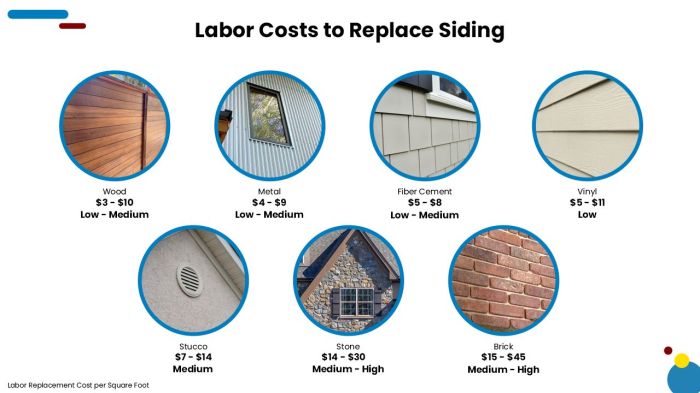
When it comes to siding a house, labor costs play a significant role in determining the overall expenses of the project. The average labor costs per square foot for siding projects typically range from $1.50 to $3.00, depending on various factors.
Variations in labor costs based on geographical location
The labor costs for siding a house can vary based on the geographical location of the project. In areas with higher living costs or where labor is in high demand, such as urban centers, labor costs tend to be higher compared to rural areas.
For example, labor costs in New York City may be significantly higher than in a small town in the Midwest.
Comparison of labor costs for different siding materials
- Vinyl Siding:Vinyl siding is relatively easy to install, leading to lower labor costs compared to other materials. The average labor costs for vinyl siding range from $1.00 to $2.50 per square foot.
- Wood Siding:Wood siding requires more skill and time to install, resulting in higher labor costs. On average, labor costs for wood siding can range from $2.00 to $4.00 per square foot.
- Fiber Cement Siding:Fiber cement siding falls in the mid-range in terms of labor costs. The average labor costs for fiber cement siding typically range from $2.00 to $3.50 per square foot.
- Stucco Siding:Stucco siding is labor-intensive and requires specialized skills, leading to higher labor costs. The average labor costs for stucco siding can range from $3.00 to $5.00 per square foot.
Influence of project complexity on labor costs per square foot
The complexity of a siding project can also impact labor costs per square foot. Projects that involve intricate designs, multiple stories, or require additional preparation work may result in higher labor costs. Contractors may charge more for challenging projects that require extra time and expertise, ultimately increasing the labor costs per square foot.
Hiring contractors for siding work
When it comes to hiring contractors for siding work, there are several crucial steps to follow to ensure you find the right professional for the job. Obtaining multiple quotes, evaluating credibility and experience, and negotiating labor costs are all essential aspects to consider.
Obtaining Multiple Quotes
Before committing to a contractor, it is important to gather quotes from multiple professionals. This allows you to compare prices, services offered, and the overall value provided. By obtaining multiple quotes, you can ensure you are getting a fair price and quality workmanship for your siding project.
Evaluating Credibility and Experience
When evaluating siding contractors, it is crucial to assess their credibility and experience in the industry. Look for contractors who have a proven track record of successful projects and positive reviews from past clients. Check for licenses, insurance, and any certifications that demonstrate their expertise in siding installation.
Negotiating Labor Costs
Once you have received quotes from different contractors and assessed their credibility, it's time to negotiate labor costs. Be upfront about your budget and expectations, and don't hesitate to discuss pricing with the contractors. Keep in mind that while cost is important, quality should not be compromised.
Work with the contractor to find a balance between affordability and excellent workmanship.
Wrap-Up
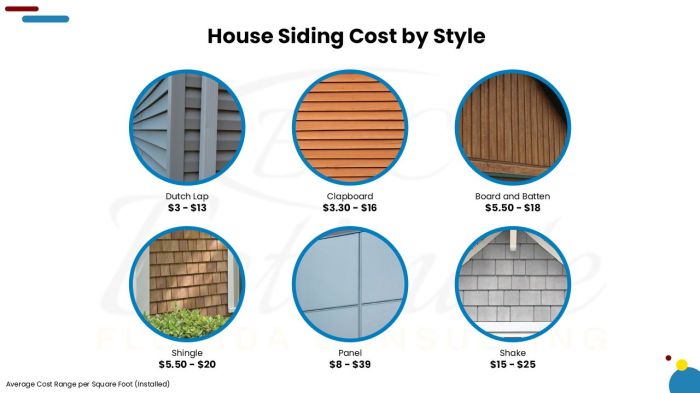
In conclusion, understanding the labor cost for siding a house is crucial for homeowners looking to enhance the aesthetic appeal and functionality of their property. By considering the factors, materials, and hiring tips Artikeld in this guide, individuals can navigate the complexities of siding projects with confidence and clarity.
Essential FAQs
How does the size of the house impact labor costs?
The larger the house, the more labor and time required for siding installation, resulting in higher costs.
What are common siding materials used for houses?
Common siding materials include vinyl, wood, fiber cement, and stucco.
How can homeowners evaluate the credibility of siding contractors?
Homeowners can check references, read reviews, and verify licenses and insurance of siding contractors to assess their credibility.

